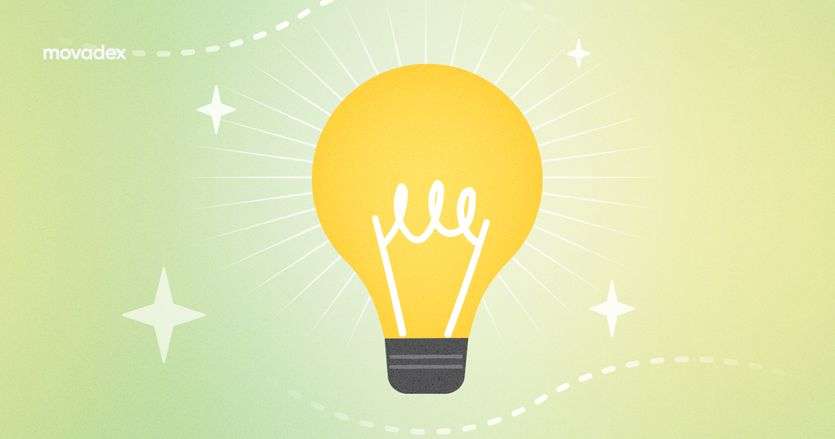A study by Nielsen Norman Group reported in “The Business Value of UX” found that companies that invest in UX design see significant benefits, including:
- A 27% increase in conversion rates
- A 55% increase in customer retention
- A 22% increase in customer satisfaction
These numbers underscore the importance of User Experience (UX) design in driving business success. And design thinking provides a structured yet flexible framework for creating UX solutions that not only meet user needs but also exceed expectations. In this article, we'll delve into the world of design thinking, exploring its core principles and how they are applied in UX design projects.
What is Design Thinking?
Design thinking is a human-centered approach to problem-solving that emphasizes empathy, creativity, and experimentation. Designers concentrate on understanding user needs, defining problems, and generating creative solutions through a dynamic process of hypothesis creation and testing. It's important to highlight that this isn't a strict step-by-step journey; each phase can happen simultaneously and be revisited multiple times. Moreover, the process inherently involves collaboration with experts from various fields, enriching the process with diverse perspectives and experiences.
For example, In developing a new mobile banking app, the design team utilizes design thinking. They empathize with users, identify issues like complex navigation, and ideate solutions for a simpler, transparent design. Through prototyping and iterative testing, the team refines the app to ensure a user-friendly interface and streamlined transaction flow. The final product, shaped by design thinking, effectively addresses user needs, offering an innovative solution in the competitive mobile banking landscape.
Goals of Design Thinking
Design thinking is a human-centered approach to define and resolve those pain points.
1. To understand users and their needs
Design thinking emphasizes empathy and understanding as the foundation for creating solutions that truly meet the needs of users. It encourages designers to step into the shoes of users, observe their behaviors, and deeply understand their motivations, pain points, and aspirations.
2. To challenge assumptions and rethink problems
Design thinking encourages designers to question existing assumptions and challenge conventional approaches to problem-solving. It promotes a mindset of curiosity and experimentation, enabling designers to explore uncharted territories and uncover new possibilities.
3. To create solutions that are user-centered and feasible
Design thinking places the user at the center of the problem-solving process. It ensures that solutions are not only creative but also aligned with user needs, preferences, and constraints. The iterative nature of design thinking allows for continuous testing and refinement of solutions, ensuring that they are not only desirable but also technically feasible and economically viable.
Designers, remember that not everything beautiful is suitable. Therefore, a design mindset with seasoning in the form of knowledge of the economy will help you stand out not only as a specialist but also as a great empath for the client.
The Design Thinking Process
Design thinking isn't a rigid, step-by-step path. Each phase can happen concurrently with others and be revisited multiple times. Additionally, the process inherently involves collaborating with people from various disciplines and specialties. Their unique perspectives and experiences contribute valuable insights, enhancing the overall process.

Step 1: Empathize
The first step is to gain a deep understanding of the needs, wants, and motivations of the people you are designing for. This involves conducting research, observing users, and interviewing them to gain insights into their lives.
Immerse yourself in the user's world to gain a deeper understanding of their context and challenges. This could involve shadowing users in their daily activities, using their products or services, or visiting their workplaces or environments. Organize and synthesize the gathered insights into an empathy map, which visually represents the user's needs, emotions, thoughts, and actions.
Tip: Consider breaking down your target audience into 3-4 segments, identifying their specific needs and how your product or service can address them. As a designer, utilize the Jobs-to-be-Done (JTBD) framework for this task. While a person owning a dog might not be crucial for a SaaS product, the significant aspect is the user's desire to entrust the responsibility entirely to your product. This distinction plays a pivotal role in shaping the design to meet their expectations effectively.

Step 2: Define
Once you have a good understanding of the problem, you need to define it in a clear, focused, and user-centered way. This involves identifying the root cause of the problem and formulating a problem statement that is specific, measurable, achievable, relevant, and time-bound (SMART).
To accurately pinpoint the problem, adhere to the following steps:
- Record all identified problems on individual stickers – each sticker representing a problem articulated by your user. Organize these stickers on a wall or board on FigJam.
- After cataloging all problems, cluster them based on shared symptoms (insights), assign titles to each group, and explore the interconnections between them. Identify critical problems, often termed 'pain points,' signaling areas for improvement.
- Identify critical 'pain points' for improvement and prioritize them through a team voting process.
You can use tools such as fishbone diagrams and mind maps to visualize the relationships between different aspects of the problem. Don’t forget to consider historical data, industry trends, and competitor analysis to understand the broader context and potential external influences.
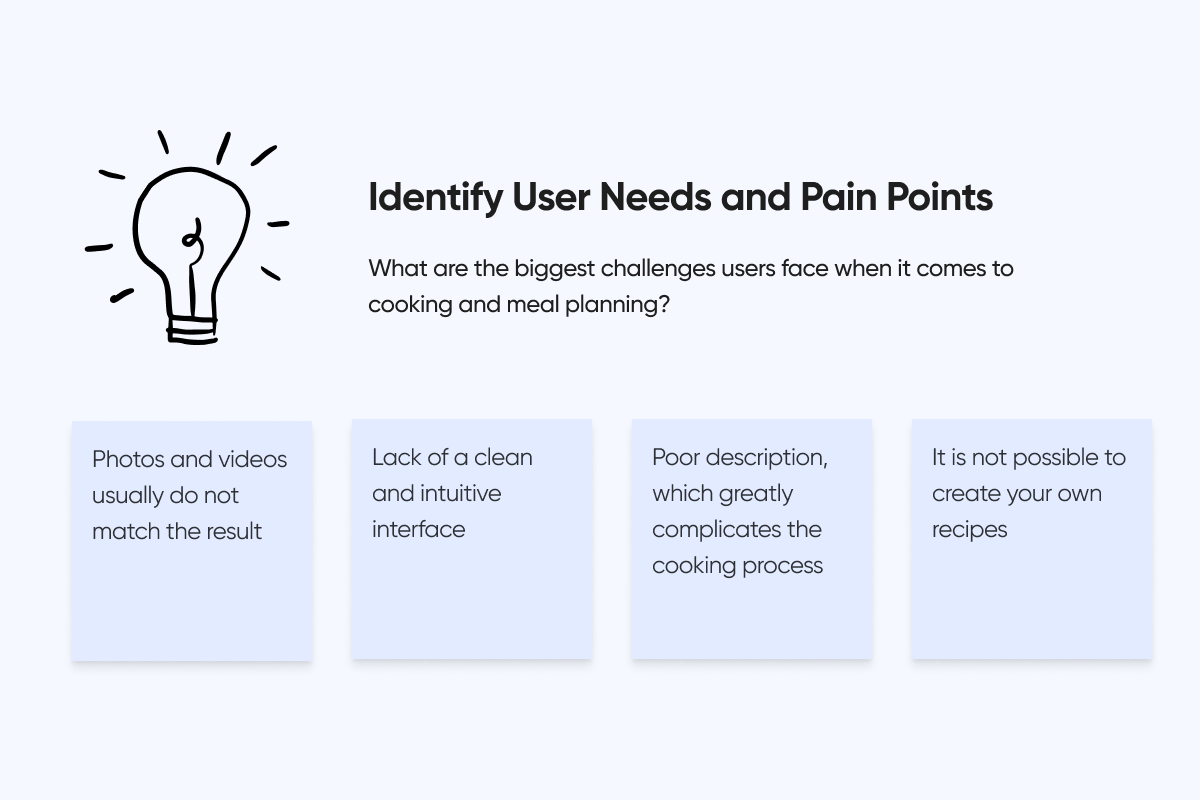
Step 3: Ideate
The goal of the ideation phase is to generate as many possible solutions to the problem as possible.
- Brainstorming: Encourage free-flowing ideas and avoid judgment or criticism during the initial brainstorming sessions.
- Sketching: Use quick and simple sketches to visualize ideas and capture concepts.
- Prototyping: Create low-fidelity prototypes to quickly test ideas and gather feedback from users and stakeholders.
Tip: Embrace every idea that comes your way. Recognize that each idea serves as the seed for potential new features. Instead, set aside the straightforward suggestions; after all, brainstorming is about fostering creativity, not sticking to the obvious.
Step 4: Prototype
Once you have a few promising ideas, you need to start creating prototypes to test them with users. Prototypes can be anything from low-fidelity sketches to high-fidelity models. The goal is to get feedback from users as early as possible so that you can iterate on your designs.
Select the most promising ideas from the ideation phase and refine them into more detailed prototypes.Incorporate feedback from early testing and iterate on the prototypes to improve functionality, usability, and user experience. Consider the overall user experience, including interactions, aesthetics, and emotional impact.
Consider factors such as scale, texture, and interaction elements to provide a realistic simulation of the user experience.
Tip: Your prototype shouldn't require a software developer. So, feel free to sketch them out on paper or dive into Figma. Just keep in mind, the aim is to gain a crystal-clear understanding of the user's problem and figure out how design can come to the rescue.

Step 5: Test
The final phase of the design thinking process is to test your prototypes with users and gather feedback. This feedback will help you to refine your designs and make sure that they are meeting the needs of users.
User testing involves recruiting diverse participants, guiding them through realistic scenarios to interact with your product, and collecting both quantitative and qualitative data. Analyze the results to identify patterns and issues, iterate on the design based on feedback, and repeat testing as needed. Share findings with the team, stakeholders, and implement recommended changes for continuous improvement.
For example, you can use surveys, A/B testing, focus groups or beta testing. When to use which?
Choose surveys when you need broad insights and quantitative data on user preferences or behaviors. A/B testing is ideal for comparing two variations of a design or feature to determine which performs better in real-world scenarios. Opt for focus groups when you seek in-depth qualitative feedback and want to explore user perceptions and attitudes. Beta testing is effective for releasing a product to a limited group of real users to gather feedback in a live environment before the full launch. Select the method that aligns with your specific testing goals and the stage of product development.
What Is Strategic Design Thinking?
As mentioned before, design goes beyond aesthetics; it's about aligning with your business mindset. People won't be captivated by the latest icons or flashy animations you incorporate. Hence, for a designer, especially in UX, cultivating strategic design thinking is crucial.
Strategic design thinking is an approach that combines the principles of design thinking with strategic planning. It involves integrating creative problem-solving methods with a long-term vision to achieve meaningful and sustainable solutions. This methodology emphasizes understanding the broader business context, user needs, and market dynamics. Designers utilizing strategic design thinking not only focus on addressing immediate challenges but also align their solutions with organizational goals and future trends. By fostering collaboration, empathy, and innovation, strategic design thinking empowers designers to contribute strategically to the overall success of a project or business.
One notable example of a company applying strategic design thinking is Apple Inc. In the early 2000s, Apple faced challenges with its product lineup, including a cluttered range of computers and a lack of cohesiveness across its software offerings. Adopting strategic design thinking, Apple's leadership, led by Steve Jobs, embarked on a transformative journey.
They empathized with users by recognizing a growing need for simplicity and seamless integration in technology. Defining the problem as a disjointed user experience, they ideated innovative solutions, resulting in a strategic shift towards unified design and user-centric products. The launch of the iPod, followed by the iPhone and iPad, showcased the integration of hardware and software with a focus on user experience.
Through prototyping and continuous testing, Apple refined its designs based on user feedback. This iterative process not only addressed immediate challenges but strategically positioned Apple as a leader in user-friendly, aesthetically pleasing technology.
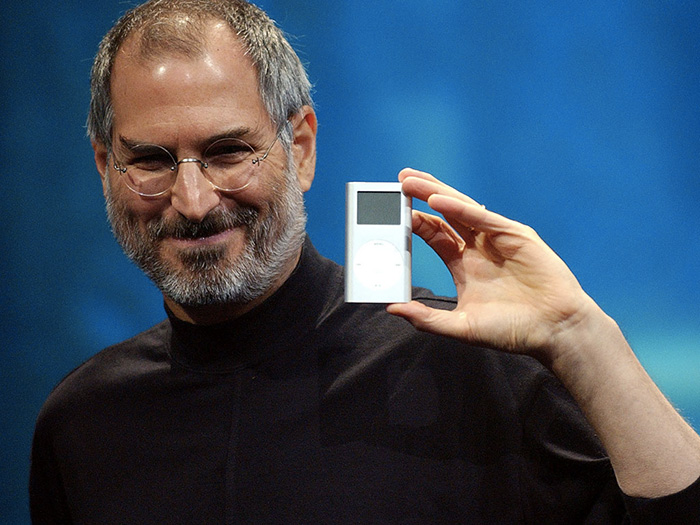
Now, let's explore our experience with designing Truffls — a mobile and web job search app based in Germany that offers a swift and enjoyable job-hunting experience. It employs a swipe-based system to quickly browse job openings.
The challenge was motivating users to complete their profiles, enhancing job recommendations, and attracting potential company interest. To address this, we gamified the design, adding completion percentages and helpful hints. We also streamlined profile setup by enabling a quick import of user details from platforms like Linkedin or XING, saving users time.
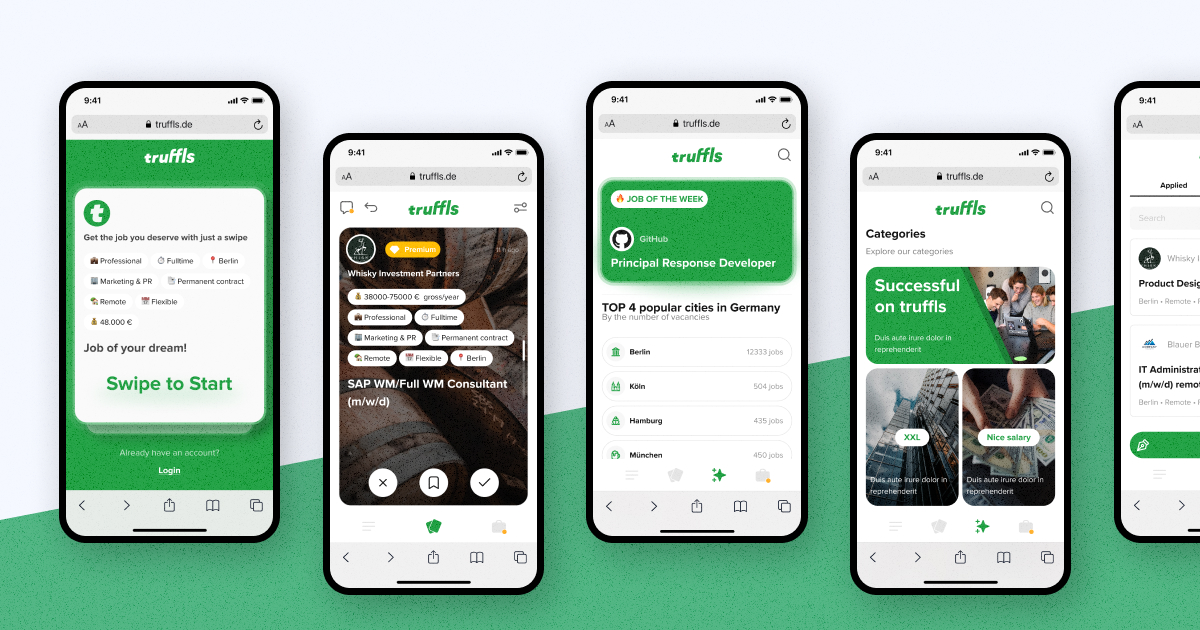
What’s a “Wicked Problem” in Design Thinking?
A "wicked problem" in design thinking refers to a complex and highly ambiguous issue that is challenging to define, analyze, and solve.
Coined by design theorist Horst Rittel, wicked problems are characterized by their lack of clear solutions and the presence of multiple, interconnected factors. These problems often involve social, economic, and political aspects, making them resistant to straightforward resolution.
Wicked problems typically have no definitive endpoint, and solutions may generate unforeseen consequences. Designers tackling wicked problems must navigate uncertainty, iterate on potential solutions, and engage with stakeholders to address the multifaceted nature of the problem. Climate change, poverty, and healthcare reform are examples of wicked problems that require holistic and collaborative approaches in the design thinking process.
Key Principles for Tackling Wicked Problems
- Iteration
Wicked problems require an iterative approach, allowing for continuous learning, adaptation, and refinement of solutions. Iteration is not about starting from scratch with each new discovery; rather, it's about building upon existing knowledge and insights to refine and improve solutions. Each iteration provides an opportunity to test assumptions, identify unintended consequences, and uncover new possibilities.
- Consider Multiple Perspectives
Involve diverse stakeholders and experts to gain a holistic understanding of the problem and its potential solutions. By engaging with individuals from various backgrounds, disciplines, and experiences, designers can gain insights into the diverse needs, perspectives, and constraints that shape the problem. This inclusive approach fosters empathy and understanding, ensuring that solutions are tailored to the needs of all affected parties.
- Embrace Uncertainty
Recognize that there may not be a single, definitive answer, and focus on creating solutions that can be adapted and improved over time. This requires a willingness to experiment, learn from failures, and pivot when necessary. It's about embracing the unknown and using it as a catalyst for innovation.
- Seek Systemic Change
Address the root causes and interconnected aspects of the problem, aiming for solutions that contribute to systemic change. Designers must strive to understand the root causes of the problem and how it interacts with other systems. This holistic perspective allows for solutions that not only address immediate needs but also contribute to systemic change, creating a more sustainable and equitable future.
What Are The Best Resources For Learning Design Thinking?
While you can certainly delve into the fundamentals through free sources, I've curated what I believe are the finest courses available at a reasonable price. My personal recommendation is to not overlook the importance of design thinking—it's an essential process for any design project.
Design Thinking for Innovation by University of Virginia (Coursera)
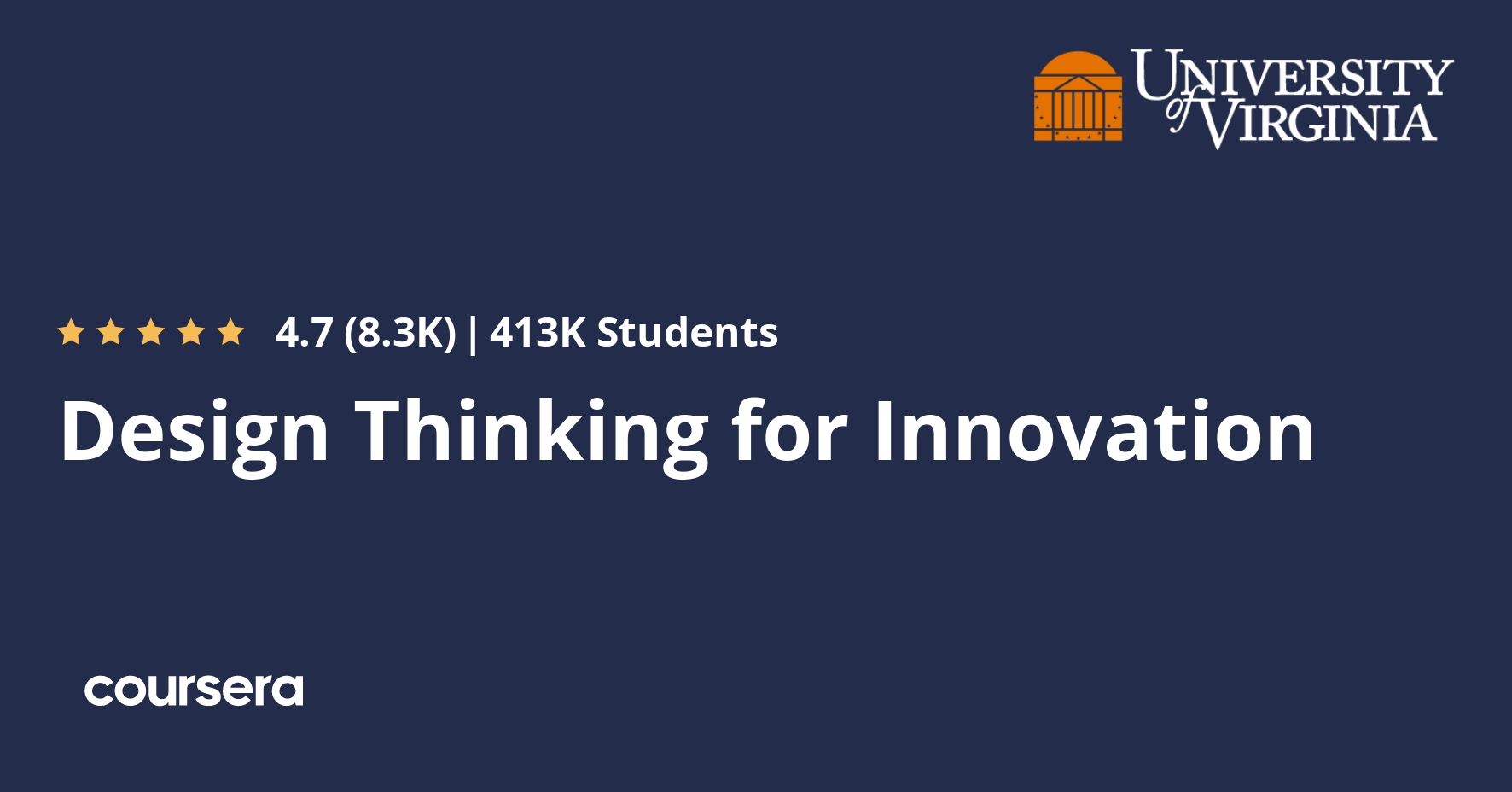
Recognized as one of Coursera's premier Design Thinking courses, this program delves into the methodologies and tools essential for fostering innovation and unleashing creativity. Focused on the application of these processes and toolkits in organizational contexts, the course revolves around a model featuring four key questions. Learners engage with various tools to comprehend design thinking as an effective problem-solving approach:
- What is happening currently?
- In an ideal scenario, what do we aspire to create in the future?
- What solutions genuinely resonate with those aiding in the creation process?
- What unfolds when we experiment in the marketplace to gauge effectiveness?
Duration: 4 weeks, 2-3 hours per week
Price: Free
Enterprise Design Thinking – IBM

IBM, being one of the world's largest companies, offers valuable insights. The company believes that it helps the teams not only form intent but deliver innovative outcomes that improve the lives of the people they serve.
Duration: 7 weeks
Price: Free
Design Thinking and Creativity for Innovation by University of Queensland (edX)

Explore design thinking tools to solve problems creatively. Apply ideas to understand customer needs in the market. Here's what you'll learn:
- The essence of human creativity and innovation.
- How creativity and design thinking solve complex business problems.
- The process and tools of design thinking.
- Various creativity and design processes for better ideas.
- Using tools to validate ideas for impact.
- Incorporating design sprints to generate and test new ideas systematically.
- Establishing organizations that foster creative and innovative thinking.
Duration: 10 weeks, 8-10 hours per week
Price: Free
Certification: Add $49
Conclusion
In conclusion, design thinking is crucial as it provides a structured and empathetic approach to problem-solving, fostering creativity and innovation. By prioritizing user needs and employing a collaborative, iterative process, design thinking ensures solutions are not only functional but also resonate with the people they serve. This human-centric methodology is essential for addressing complex challenges, adapting to evolving circumstances, and ultimately, creating impactful and sustainable outcomes in various fields.
Looking for more inspiration? Explore our Behance for additional creative ideas with a focus on human-centric design.

